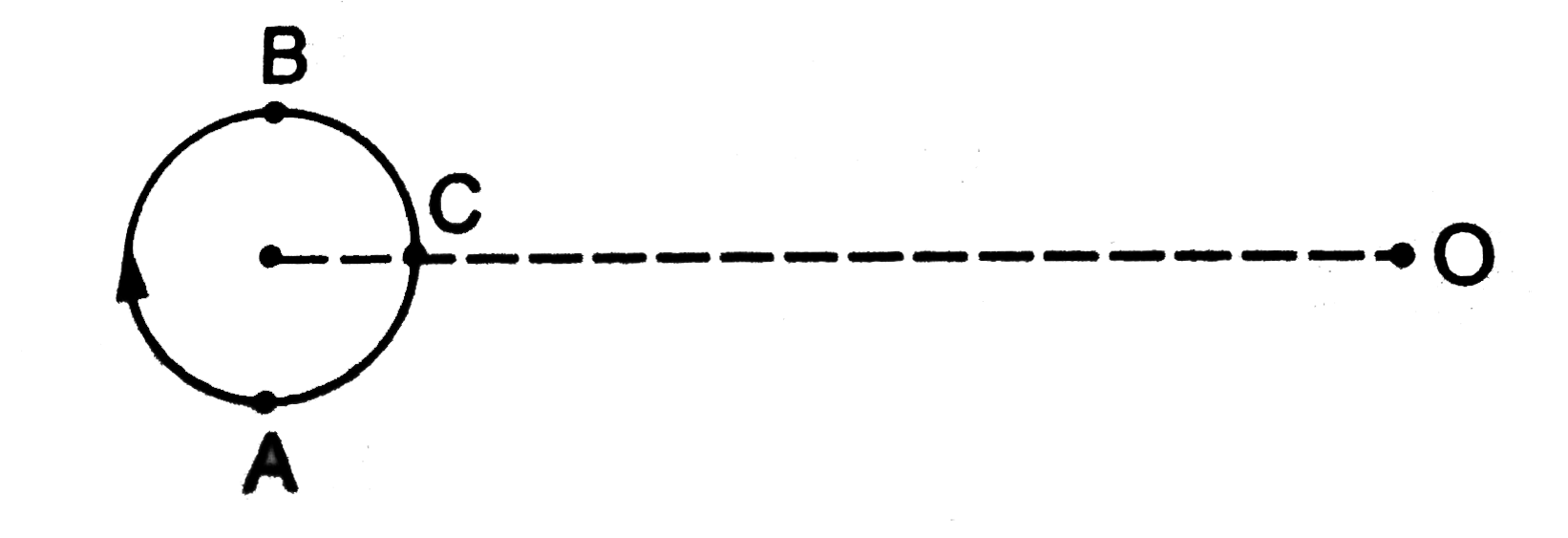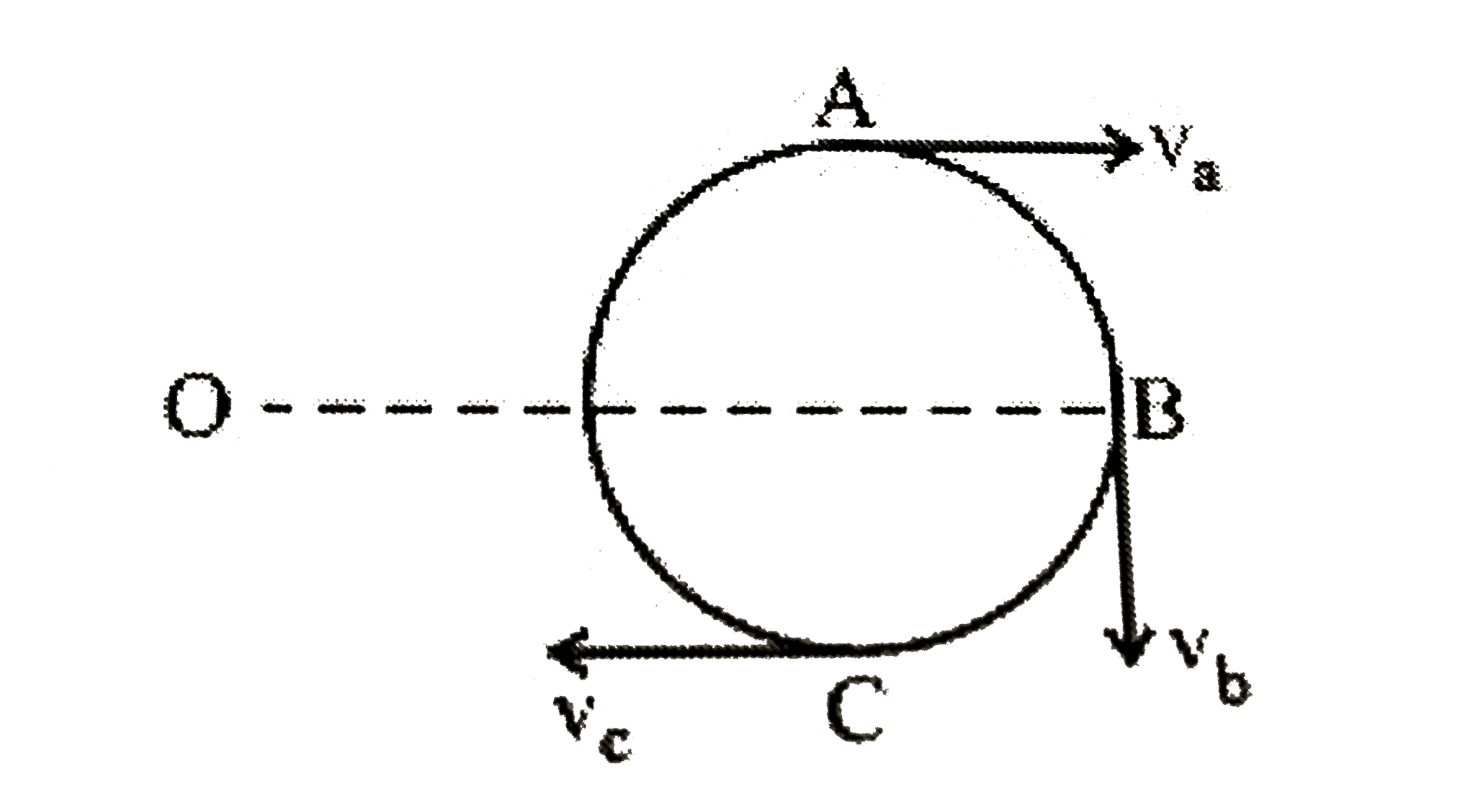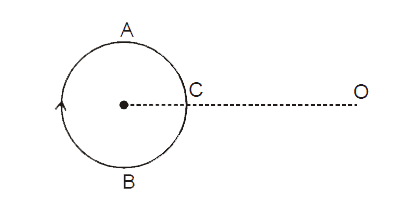A small source of sound moves on a circle as shown in figure and an observer is sitting at O. Let v1,v2,v3 be the frequencies heard when the source is at A,B and C respectively.
 .
.
f1>f2>f3
f2>f3>f1
f1=f2>f3
f2>f1>f3
The correct Answer is:B
At point A, source is moving away
f1<f
At point B, source is coming towards
f2>f
At point C, source is moving ⊥r to observer
f3=f
Hence, f2>f3>f1.
Topper's Solved these Questions
- BOOK - ERRORLESSCHAPTER - WAVES AND SOUND EXERCISE - NCERT BASED QUESTIONS (MUSICAL SOUND)17videos
WAVES AND SOUND
- BOOK - ERRORLESSCHAPTER - WAVES AND SOUND EXERCISE - PAST YEARS QUESTIONS45videos
WAVES AND SOUND
- BOOK - ERRORLESSCHAPTER - WAVES AND SOUND EXERCISE - NCERT BASED QUESTIONS (ORGAN PIPE (VIBRATION OF AIR COLUMN))16videos
WAVES AND SOUND
- BOOK - ERRORLESSCHAPTER - UNITS, DIMENSIONS AND MEASUREMENTEXERCISE - ASSERTION & REASON17videos
UNITS, DIMENSIONS AND MEASUREMENT
- BOOK - ERRORLESSCHAPTER - WORK, ENERGY POWER AND COLLISIONEXERCISE - ASSERTION & REASON22videos
WORK, ENERGY POWER AND COLLISION
Similar Questions
Which of the following has highest pitch in their sound ?
02:01View SolutionIn a sinusoidal wave, the time required for a particular point to move from maximum displacement to zero displacement is 0.170 second. The frequency of the wave is
02:01View SolutionIf the temperature increases, then what happens to the frequency of the sound produced by the organ pipe ?
02:11View SolutionAssertion : 'Light year' and 'Wavelength' both measure distance.
Reason : Both have dimensions of time.02:37View SolutionAssertion : If two protons are brought near one another, the potential energy of the system will increase.
Reason : The charge on the proton is +1.6×10−19C04:24View SolutionA small source of sound moves on a circle as shown in figure and an observer is sitting at O. Let v1,v2,v3 be the frequencies heard when the source is at A,B and C respectively.
 .04:46View Solution
.04:46View SolutionA small source of sound moves on a circle as shown in figure and an observer is sitting at O. Let v1,v2,v3 be the frequencies heard when the source is at A,B and C respectively.
 .08:26View Solution
.08:26View SolutionThe source producing sound and an observer both are moving along the direction of propagation of sound waves. If the respective velocities of sound, source and an observer are v,vs and v0, then the apparent frequency heard by the observer will be (n = frequency of sound)
03:46View SolutionIf a source sounding a whistle with a constant frequency moves in a circle and frequencies observed by observer O, when the source is at points A, B, C be v_(a) , v_(b) , v_(c) ,then
View SolutionA source and an observer are situated on two perpendicular tracks as shown in the figure the observer is at rest and source is moving with a speed 50m//s the source emits sound waves of frequency 90Hz which travel in the medium with velocity 200m//s the frequency of sound heard by observer when the source crosses the origin is
02:37View SolutionIf a source sounding a whistle with a constant frequency moves in a circle and frequencies observed by observer O, when the source is at points A,B,Cbeνaa,νb,νc then :-
 03:12View Solution
03:12View SolutionThe frequency for a series limit of Balmer and paschen serial respectively are f1andf3 if the frequency of the first line of Balmer series is then the relation between f1,f2andf3 is
05:02View SolutionA small source of sound moves on a circle as shown in fig. and an observer is sitting at O. Let at v1,v2,v3 be the frequencies heard when the source is at A, B and C respectively.
 View Solution
View SolutionA small source of sound moves on a circle of radius r with constant speed V_s . eta is the actual frequency of the source. For the positions of the source indicated in the figure find the frequency as heard by three observers at the points P,O & Q respectively
02:29View Solutionजब समान आयाम किन्तु थोड़ी भिन्न आवृत्तियों, v1एवं v2 के दो ध्वनि स्रोतों को एक-साथ बजाया जाता है, तो सुनाई देने वाली ध्वनि की आवृत्ति बराबर होती है
02:04View SolutionA small source of sound moves on a circle as shown in figure and an observer is sitting at O. Let v1,v2,v3 be the frequencies heard when the source is at A,B and C respectively.
 .04:59View Solution
.04:59View Solution

